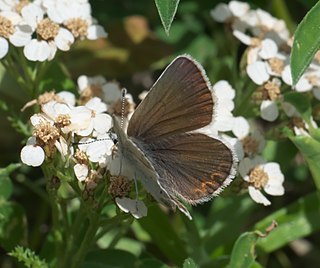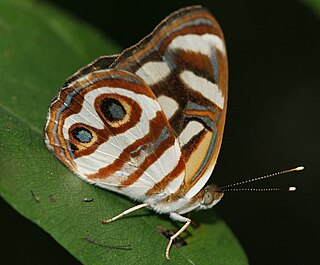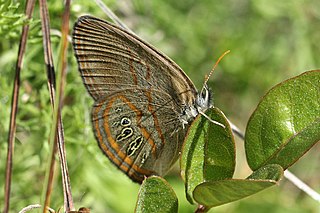
Papilio glaucus, the eastern tiger swallowtail, is a species of butterfly native to eastern North America. It is one of the most familiar butterflies in the eastern United States, ranging north to southern Ontario, Canada, and is common in many different habitats. It flies from spring until fall, during which it produces two to three broods. Adults feed on the nectar of many species of flowers, mostly from those of the families Apocynaceae, Asteraceae, and Fabaceae. P. glaucus has a wingspan measuring 7.9 to 14 cm. The male is yellow with four black "tiger stripes" on each forewing. Females may be either yellow or black, making them dimorphic. The yellow morph is similar to the male, but with a conspicuous band of blue spots along the hindwing, while the dark morph is almost completely black.

Sistrurus miliarius, commonly called the pygmy rattlesnake, is a species of venomous snake in the subfamily Crotalinae of the family Viperidae. The species is endemic to the Southeastern United States. Three subspecies are currently recognized.

The western pygmy blue is one of the smallest butterflies in the world and the smallest in North America. It has reached Hawaii, as well as the Persian Gulf, including eastern Saudi Arabia, Bahrain and the United Arab Emirates.

Brephidium is a genus of butterflies in the family Lycaenidae. They are known commonly as pygmy blues. The species of this genus have a disjunct distribution. Two of the three species are found in the Americas while the third is found in Africa.
Brephidium metophis, the tinktinkie blue, is a butterfly of the family Lycaenidae. It is found in southern Africa, including South Africa, Botswana, Mozambique and Zimbabwe. In South Africa, it is found from the Western Cape, north to Namaqualand, which is found both in the northern part of the Western Cape province and the Northern Cape, and east to the Eastern Cape, KwaZulu-Natal and the western part of the Free State province.

Euphyes bimacula, the two-spotted skipper, is a butterfly of the family Hesperiidae. It is found in North America, from northeast Colorado and western Nebraska; eastern Nebraska east to southern Quebec; southern Maine south to central Virginia; coastal plain south to Georgia; and the Gulf Coast.

Lethe creola, the creole pearly-eye, is a species of brush-footed butterfly in the family Nymphalidae. It is found it the United States from North Carolina and central Georgia west to eastern Oklahoma and eastern Texas. Some authorities include this species in the genus Enodia as Enodia creola.

Ochlodes agricola, the rural skipper, is a species of grass skipper in the butterfly family Hesperiidae. It is found in Central America and North America.
Cecropterus casica, the desert cloudywing, is a species of dicot skipper in the butterfly family Hesperiidae. It is found in Central America and North America.

Erynnis tristis, commonly known as the mournful duskywing, is a species of spread-wing skipper in the butterfly family Hesperiidae. It is found in Central America, North America, and South America. It is mottled brown with a white fringe on the hind wings. It appears similar to the funereal duskywing, but the mournful duskywing is more likely to appear in urban areas. The larva feeds on young oaks while adults nectar from a variety of wild and garden flowers.

Plebejus anna, or Anna's blue, is a species of blue in the butterfly family Lycaenidae. It is found in North America.

Celastrina echo, known generally as the echo azure or western azure, is a species of blue in the butterfly family Lycaenidae.
Euphilotes mojave, known generally as the Mojave dotted blue or Mojave blue, is a species of blue in the butterfly family Lycaenidae. It is found in North America.
Languria taedata is a species of lizard beetle in the family Erotylidae. Dark and elongate, it is 9mm to 11mm long. Its larvae grow inside the stems of cordgrass. It is found in North America, especially along the eastern coastal states.

Satyrium semiluna, known generally as the sagebrush sooty hairstreak or half-moon hairstreak, is a species of hairstreak in the butterfly family Lycaenidae. It is found in North America. The MONA or Hodges number for Satyrium semiluna is 4277.1.

Dynamine dyonis, the blue-eyed sailor, is a species of tropical brushfoot in the butterfly family Nymphalidae. It is found in North America.

Memphis pithyusa, known generally as the pale-spotted leafwing or blue leafwing, is a species of leafwing in the butterfly family Nymphalidae. It is found in southern North America.
Philotiella speciosa, the small blue, is a species of blue in the butterfly family Lycaenidae.

Cyclargus ammon, known generally as the nickerbean blue or Lucas' blue, is a species of blue in the butterfly family Lycaenidae. It is found in the Caribbean Sea and North America.

Neonympha areolatus, the Georgia satyr, is a species of brush-footed butterfly in the family Nymphalidae. It is found in North America.
















